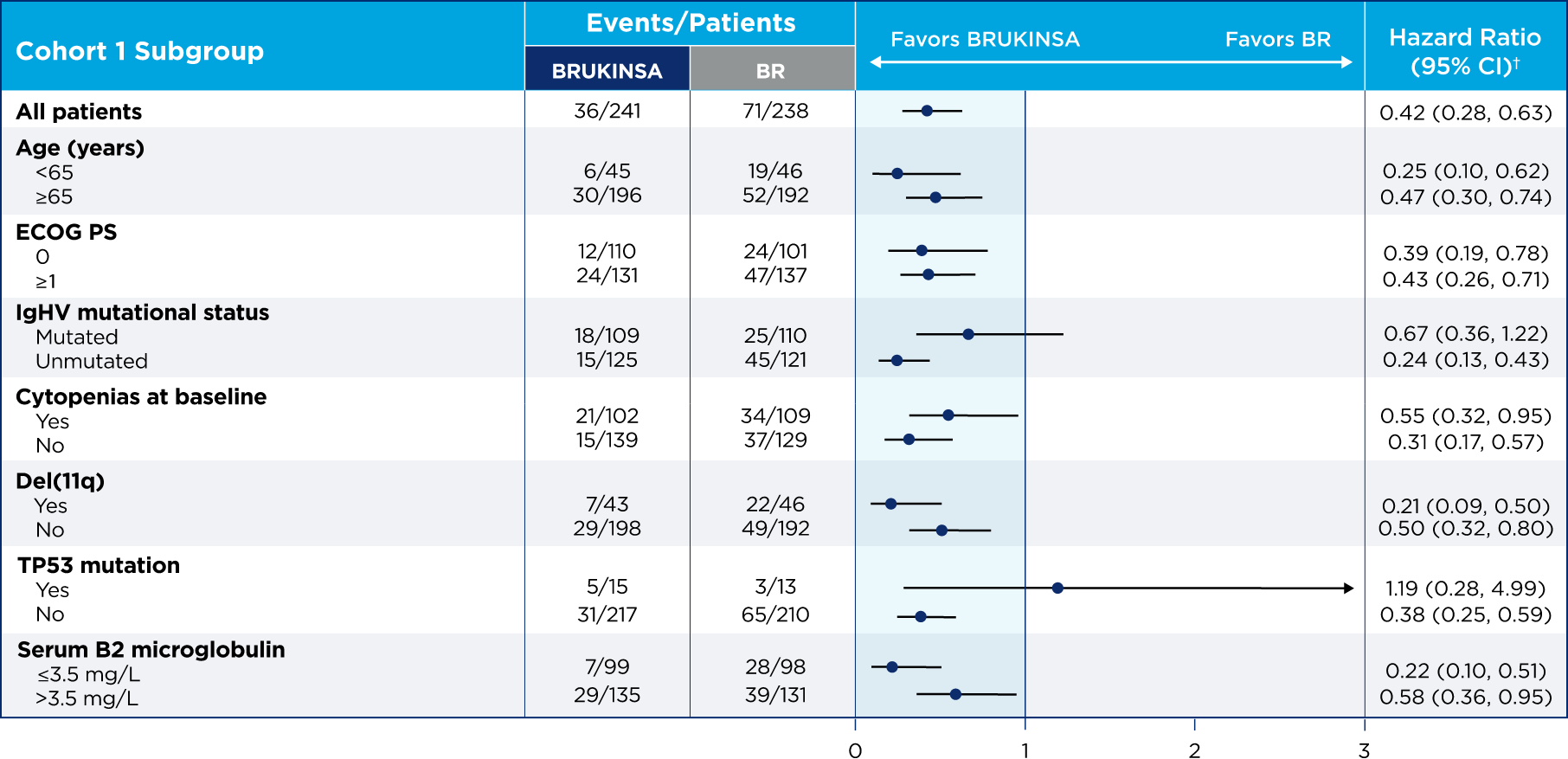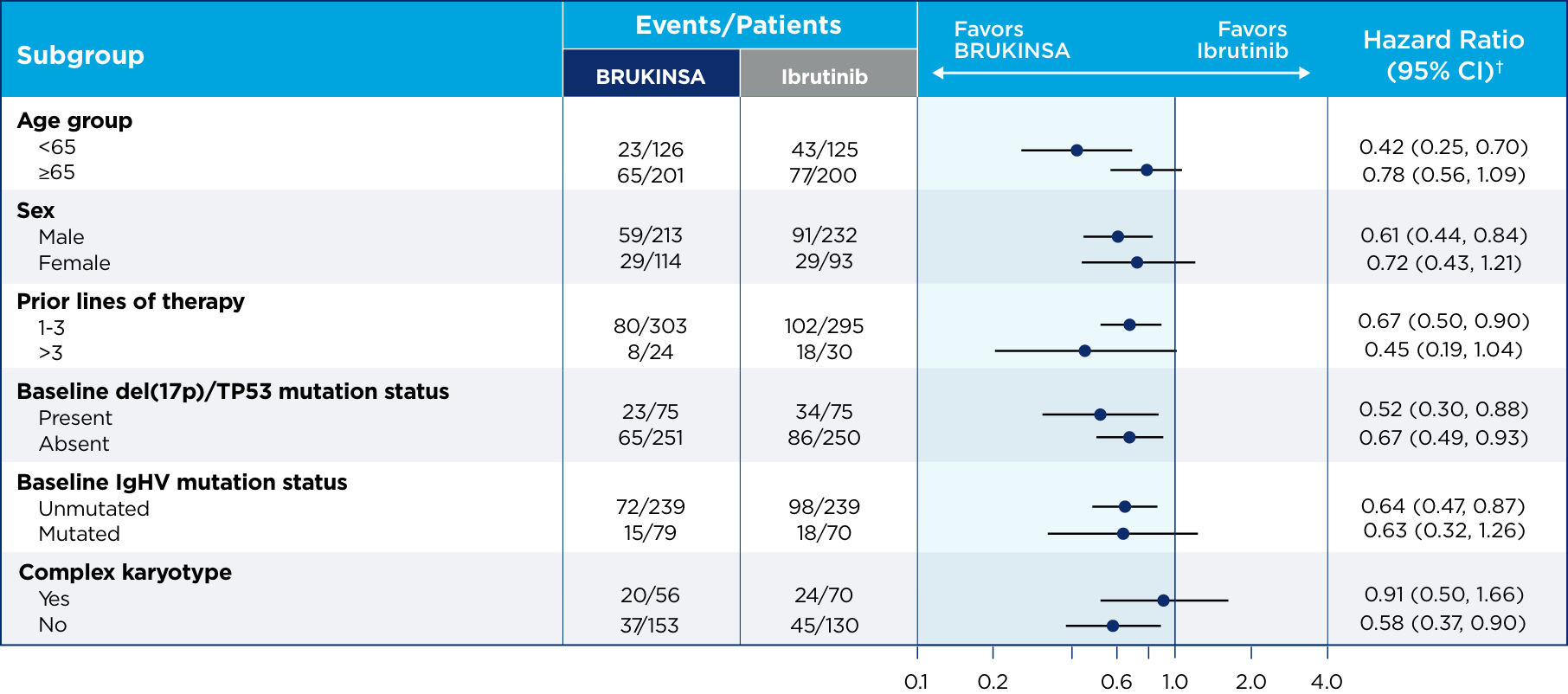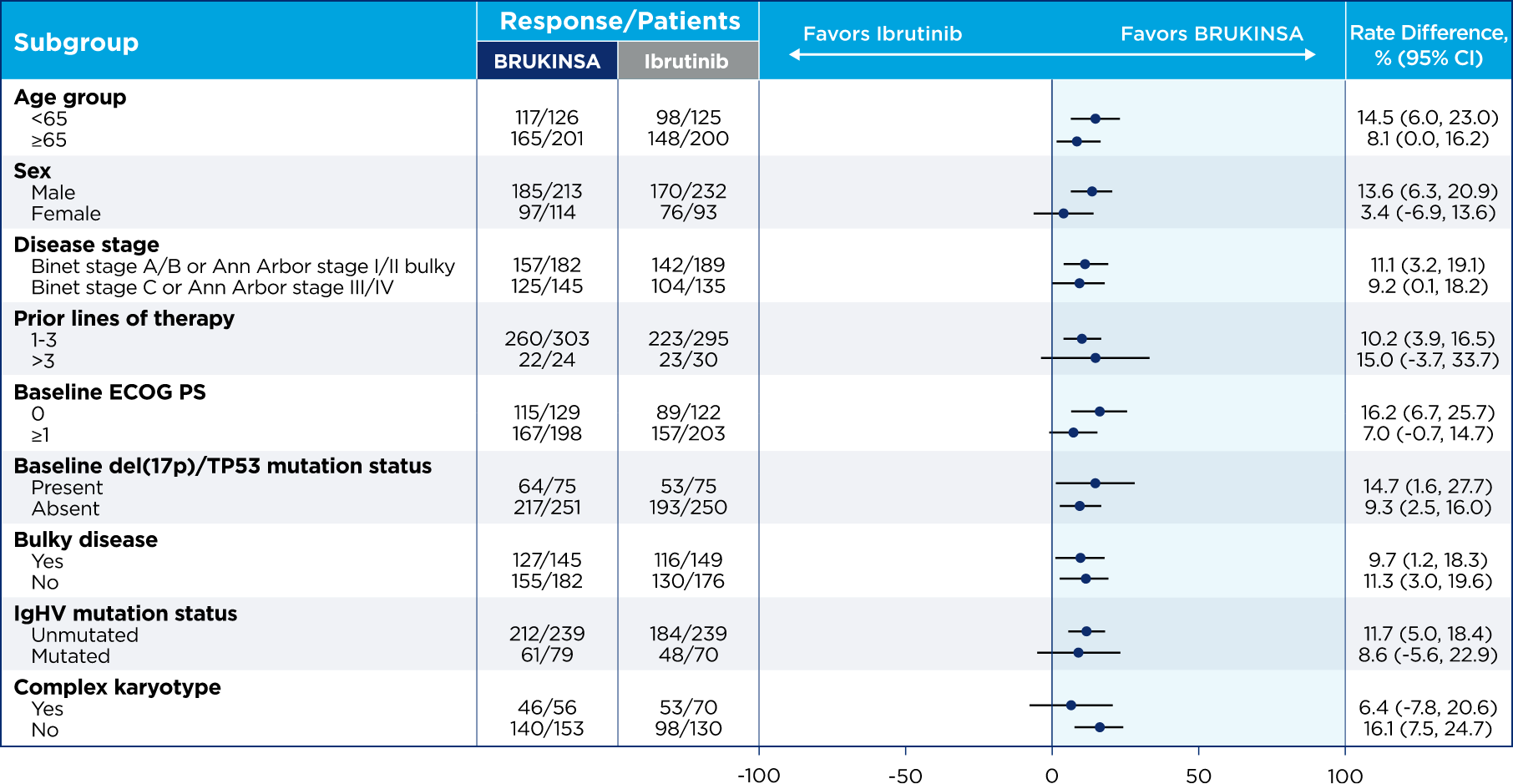BRUKINSA patients can call the myBeiGene® patient support program to talk to a dedicated nurse: 1-833-BEIGENE (1-833-234-4363)
(Cohort 1)

(Cohort 2)

*Median PFS was not reached in either arm at the initial analysis.1,2
†Prespecified analysis assessed by IRC.2
‡Median follow-up at the initial analysis: 26.2 months.2
§Long-term exploratory analysis.
PFS GENERALLY FAVORED BRUKINSA AT INITIAL ANALYSIS, REGARDLESS OF MUTATION OR RISK STATUS*2

All subgroup analyses are exploratory and descriptive in nature.
*Assessed by IRC.2
†Hazard ratio and 95% CI were from stratified (for all patients) or unstratified analysis (for subgroup) Cox regression model with BR arm as the reference group.2
Cohort 1: without del(17p)/TP53
secondary endpoint*
93% ORRwith BRUKINSA at ~2 years
(95% CI: 89.0, 96.0) vs 85%
with BR (95% CI: 80.0, 90.0)
Cohort 2: with del(17p)
secondary endpoint†
88% ORRwith BRUKINSA
(95% CI: 81.0, 94.0)
*Prespecified analysis assessed by IRC; median follow-up of 26.2 months.2
†Prespecified analysis assessed by IRC; median follow-up of 30.5 months.2
1L=first line; BR=bendamustine+rituximab; CI=confidence interval; ECOG PS=Eastern Cooperative Oncology Group performance status; HR=hazard ratio; IRC=independent review committee; ORR=overall response rate; PFS=progression-free survival.
READ THE SEQUOIA (1L) PUBLICATION

*Prespecified analysis assessed by both IRC and investigator with similar results. Median PFS has not yet been reached with BRUKINSA vs 34 months with ibrutinib.4
†Median follow-up: 31 months.1
‡All analyses are exploratory and descriptive in nature.

All subgroup analyses are exploratory and descriptive in nature.
*Assessed by both IRC and investigator with similar results.4
†Hazard ratio and 95% CI were unstratified for subgroups.4
(25 months for ORR)

Median follow-up: 24.7 months6
With BRUKINSA, 92% of patients sustained a response vs 86% with ibrutinib at 1 year1
Statistical analysis for ORR was conducted for noninferiority. When noninferiority was met, superiority was tested.4
*Assessed by both IRC and investigator with similar results.1,4


All subgroup analyses are exploratory and descriptive in nature.
Assessed by both IRC and investigator with similar results. Median follow-up of 24.7 months.1,4,6
2L=second line; BTKi=Bruton's tyrosine kinase inhibitor; CI=confidence interval; CR=complete response; CRi=complete response with absolute neutrophil count <1,000/µL; ECOG PS=Eastern Cooperative Oncology Group performance status; HR=hazard ratio; IRC=independent review committee; nPR=nodular partial response; ORR=overall response rate; PFS=progression-free survival; PR=partial response; PR–L=partial response with lymphocytosis.
READ THE ALPINE (2L) PUBLICATIONDr Anthony Nguyen discusses efficacy data across mutations and risk status in CLL
DISCOVER MORE VIDEOSIMPORTANT SAFETY INFORMATION
What should I tell my healthcare provider before taking BRUKINSA?
Before taking BRUKINSA, tell your healthcare provider about all of your medical conditions, including if you:
- have bleeding problems.
- have had recent surgery or plan to have surgery. Your healthcare provider may stop BRUKINSA for any planned medical, surgical, or dental procedure.
- have an infection.
- have or had heart rhythm problems.
- have high blood pressure.
- have liver problems, including a history of hepatitis B virus (HBV) infection.
- are pregnant or plan to become pregnant. BRUKINSA can harm your unborn baby. If you are able to become pregnant, your healthcare provider may do a pregnancy test before starting treatment with BRUKINSA.
- Females should avoid getting pregnant during treatment and for 1 week after the last dose of BRUKINSA. You should use effective birth control (contraception) during treatment and for 1 week after the last dose of BRUKINSA.
- Males should avoid getting female partners pregnant during treatment and for 1 week after the last dose of BRUKINSA. You should use effective birth control (contraception) during treatment and for 1 week after the last dose of BRUKINSA.
- are breastfeeding or plan to breastfeed. It is not known if BRUKINSA passes into your breast milk. Do not breastfeed during treatment with BRUKINSA and for 2 weeks after the last dose of BRUKINSA.
Tell your healthcare provider about all the medicines you take, including prescription and over-the-counter medicines, vitamins, and herbal supplements. Taking BRUKINSA with certain other medications may affect how BRUKINSA works and can cause side effects.
What are the possible side effects of BRUKINSA?
BRUKINSA may cause serious side effects, including:
- Bleeding problems (hemorrhage). Bleeding problems are common with BRUKINSA, and can be serious and may lead to death. Your risk of bleeding may increase if you are also taking a blood thinner medicine. Tell your healthcare provider if you have any signs or symptoms of bleeding, including:
- blood in your stools or black stools (looks like tar)
- pink or brown urine
- unexpected bleeding, or bleeding that is severe or you cannot control
- vomit blood or vomit that looks like coffee grounds
- cough up blood or blood clots
- increased bruising
- dizziness
- weakness
- confusion
- change in speech
- headache that lasts a long time
- Infections that can be serious and may lead to death. Tell your healthcare provider right away if you have fever, chills, or flu-like symptoms.
- Decrease in blood cell counts (white blood cells, platelets, and red blood cells). Your healthcare provider should do blood tests during treatment with BRUKINSA to check your blood counts.
- Second primary cancers. New cancers have happened in people during treatment with BRUKINSA, including cancers of the skin or other organs. Your healthcare provider will check you for other cancers during treatment with BRUKINSA. Use sun protection when you are outside in sunlight.
- Heart rhythm problems (atrial fibrillation, atrial flutter, and ventricular arrhythmias) that can be serious and may lead to death. Tell your healthcare provider if you have any of the following signs or symptoms:
- your heartbeat is fast or irregular
- feel lightheaded or dizzy
- pass out (faint)
- shortness of breath
- chest discomfort
The most common side effects of BRUKINSA include:
- decreased white blood cell count
- decreased platelet count
- upper respiratory tract infection
- bleeding
- muscle, bone, or joint pain
These are not all the possible side effects of BRUKINSA. Call your doctor for medical advice about side effects. You may report side effects to FDA at 1-800-FDA-1088.
What is BRUKINSA?
BRUKINSA is a prescription medicine used to treat adults with:
- Chronic lymphocytic leukemia (CLL) or small lymphocytic lymphoma (SLL).
- Waldenström’s macroglobulinemia (WM).
- Mantle cell lymphoma (MCL) who have received at least one prior treatment for their cancer.
- Marginal zone lymphoma (MZL) when the disease has come back or did not respond to treatment and who have received at least one certain type of treatment.
- Follicular lymphoma (FL), in combination with the medicine obinutuzumab, when the disease has come back or did not respond to treatment and who have received at least two prior treatments.
It is not known if BRUKINSA is safe and effective in children.
Please see full Prescribing Information including Patient Information.

